Originally posted 2017-07-27 13:50:03.
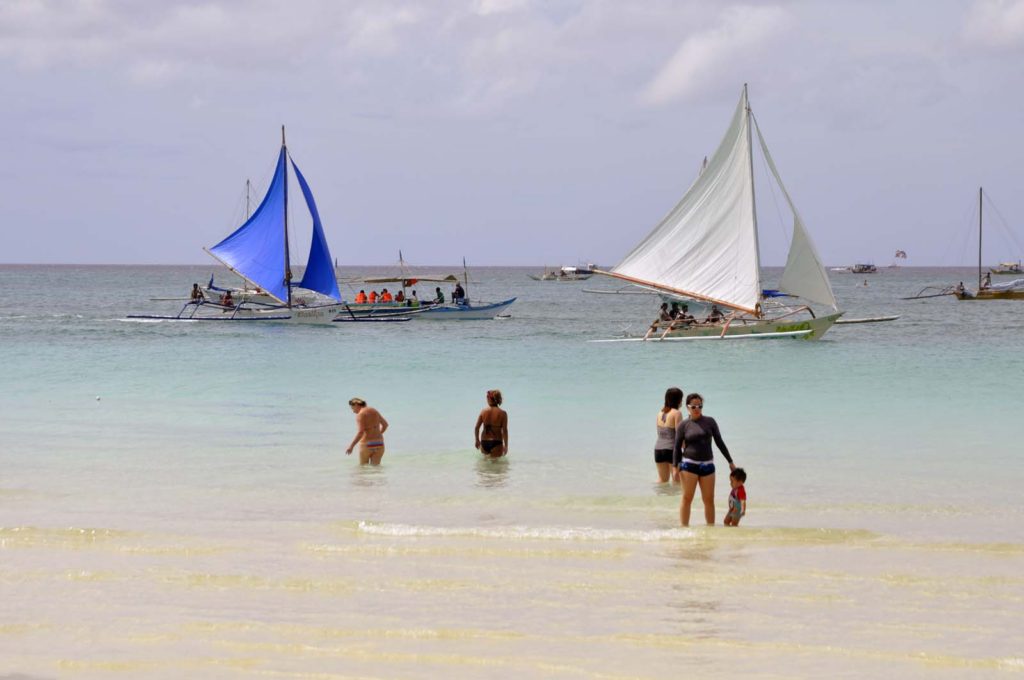
Boracay: White Sand and Plenty of Fun
Boracay is a bouquet of impressions. Triangular sails silhouetted against the sunset, tropical forest all around, an avenue of palms along the beach. Pure white sand, clear, unpolluted tropical water, adventure excursions, fun night-life and a laid-back atmosphere—not to mention exotic dancing girls. All this at prices that remain very reasonable. Does this appeal? Well, instead of Phuket or Bali, consider a trip to Boracay instead.
Boracay (pronounced bor-AH-cay) is an island in the Western Visayas region of the Philippines. It’s a popular resort amongst Filipinos and other Asians. It has an amazing beach, lots of eco-tourism and adventure sport, and great night-life. However it is relatively unknown by Western tourists, and remains fairly unspoiled and friendly. Plus, for Brits and other anglophones, English is almost universally understood and very widely spoken in the Philippines.
Getting There
There are two practical routes to Boracay, whether you’re going direct from Manila or visiting Cebu, the capital of the Visayas region, first. The simplest and cheapest is to fly to Kalibo on the island of Panay. Kalibo Airport is just over one hour’s flying time from Manila’s recently-built Ninoy Aquino International Airport, and there are flights from Cebu, which also has international flight connections. There are several domestic budget carriers, including Zest, Cebu Pacific and Air Philippines.
From Kalibo, take an air-conditioned minibus to Caticlan-Tabon Boat Terminal. This trip takes about two hours. From the terminal, take a motor-trimaran or banca to Boracay Island itself, a voyage of around twenty minutes. Once on the island, there are few taxis, so take either a tricycle, which is a motorcycle and side-car with a roof, or a ‘bus’ (really a pickup truck with seats) to your hotel. If you have booked through an agent or telephoned the hotel to say you’ve arrived, they should send a courtesy vehicle.
The alternative is to fly to the small airport at Caticlan itself, and take the ferry to Boracay as above. However, these services are far less frequent and much more expensive than those to Kalibo.
The Resort
The main resort at Boracay stretches along about one mile of beach, from Station One in the north to Station Three in the south. The deluxe hotels are mainly in Station One, with midrange and budget accommodation elsewhere. The resort is on the western side of a narrow isthmus in the centre of the island, with the town stretched along inland in typical resort strip-development style.
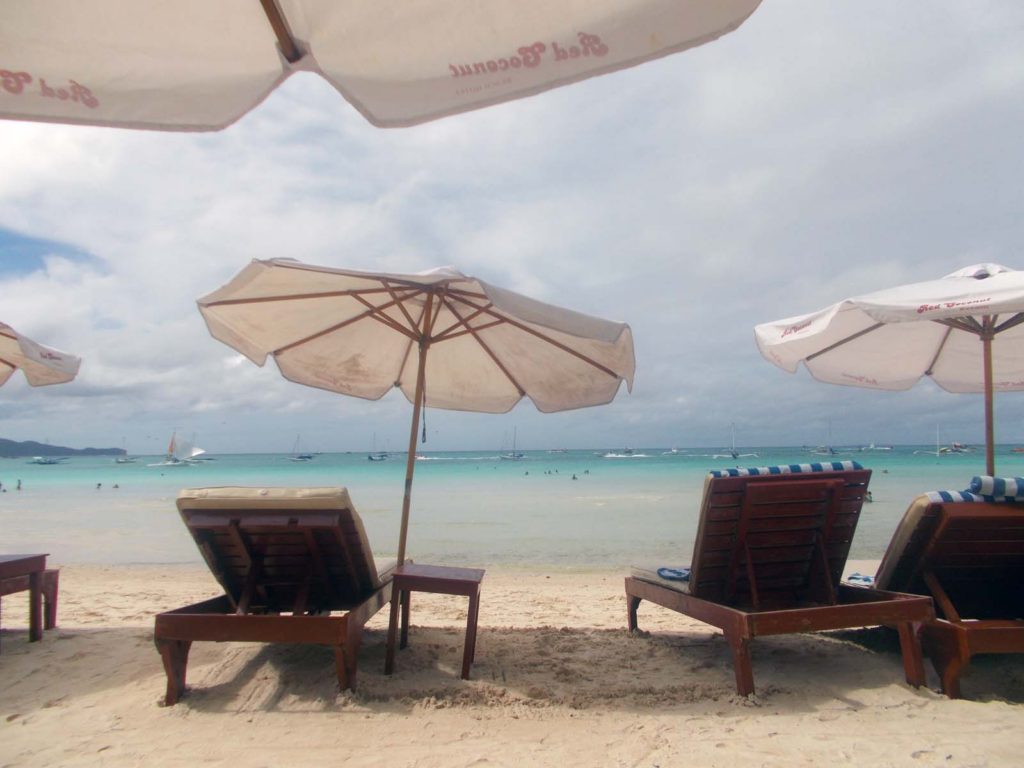
The Beach
Once there, the first place to hit is the beach to unwind from the travelling. This is one of the finest anywhere, pure white sand gently sloping into crystal blue water. Even at the height of the season, however, the crowds are numbered in the hundreds, not thousands, and the convoluted journey there suddenly seems like a real plus point.
An avenue of palms separates Boracay beach from the buildings, but there is no traffic along the narrow road, pedestrians only. In fact nearly all of the resort is free of wheeled vehicles, which really makes the place seem relaxed, compared to other resorts where the endless bustle of cars and motorcycles is an ever-present source of noise and stress. In Boracay, life is at the human pace.
The beach itself is off-limits to the vendors, and the smiling armed security men (a common feature everywhere in the Philippines) ensure that they stay on the road. As soon as you set foot on the beach you can feel the relaxation taking over. Boracay really is a tropical paradise, and as you survey the scene, the glorious white sand beach that goes on for miles, the crystal blue-green sea, the waving lines of beach-front palms and the blue hills in the distance, the traditional outrigger boats with their colourful triangular sails, this truth is inescapable.
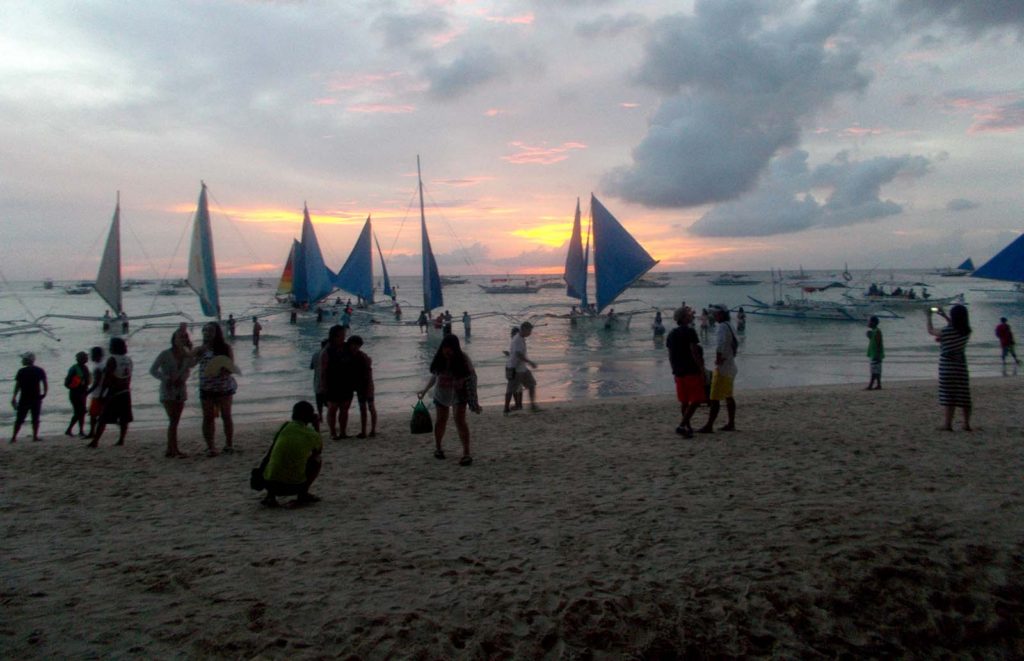
All of the bars provide luxurious recliners and umbrellas on the beach itself and most don’t charge, though it is polite to buy a drink or two. Towel hire for the day is about eighty pence. Why not treat yourself or your loved one to a manicure and pedicure, for about £5, or a massage, for about the same? Waiters, smiling hugely, circulate around the recliners. There’s no surcharge for drinks or food on the beach. In a nice touch, the beach itself is a strict no-smoking/no-litter zone.
Shopping
In Station Two there’s an open-air shopping area called D’Mall, with lots of small cantina-style restaurants serving traditional Filipino cuisine, as well as the ubiquitous Jollibee fast-food outlet. Prices are very reasonable, with a main course, soft drink and dessert ranging from £2.00 to £3.00 each. These places are clean and the food is good. Most offer ‘unli’ or unlimited rice, so you can eat as much as you like. Further along in Station Three the restaurants are a little more upmarket, though still very good value, and in Station One there are European and international-style restaurants with prices to match.
D’Mall has a forest of small boutiques selling shoes, clothes and accessories, beach and swimming equipment, and has several ATM machines. The police station is also located here. Boutique prices are fair but compare to Manila malls. If you want cheaper, then walk back away from the beach to the main road that leads through Boracay town, which is full of more traditional Filipino shops and restaurants.
My travelling companion, after a quick check of the competition, decided that she couldn’t possibly be seen on the beach in the bikini she’d brought, so I duly traipsed around the beachwear shops with her. In one, while she disappeared into a changing-booth with a few minute scraps of material, a gaggle of young Koreans arrived and did the same. Moments later I was surrounded by a half dozen girls, all wearing about six square inches of cloth and comparing each other’s choices, while completely ignoring me as I intently studied the ceiling. I was rescued when my friend asked me to give my opinion on hers.
Vendors work the beach road and will try to pressure-sell, but Filipinos are amongst the most laid-back of Asians. Many sell jewellery, much of it made from pearl. The prices are attractive but if you’re tempted, make sure the pearls are genuine by gently biting with your teeth–fake pearls usually slip. (All the ones I tried passed the test.) Others sell everything from sunglasses to sun-hats to flip-flops to cigarettes and soft drinks.
Activities
If just lying on a tropical beach while being pampered and occasionally immersing yourself in comfortably warm water gets too monotonous, Boracay offers plenty of other activities. Parasailing is the most thrilling, as you are flown up into the air suspended from a kite towed by a speedboat. There are organised diving trips to suit all abilities, and dive-equipment hire for those with the proper certificates. Island-hopping day trips begin at £15 with lunch included. There is horse-riding and a even a pro-designed golf resort.
Traditional Philippines sailing boats called paraw are available for hire, with crew, from £25 per day. These will take four passengers upwards, and it’s a very relaxed way to visit local scenic highlights like Crocodile Island, Puka Shell Beach, Panoly Beach and Crystal Cove. Alternatively, if you fancy a shorter sail, there are plenty of paraws working along the beach, with prices from £8 per person for an hour.

Nightlife
In many ways, though, apart from the magnificent beach, what makes Boracay great is the night-life. As the early tropical evening falls, the strip along the beach transforms into a neon palm-tree wonderland and the beach-front bars begin to fill up. Filipino beers cost around £1.30 for a 330ml bottle. American and some European beers are also available, but I highly recommend Red Horse, made by the San Miguel brewery (you didn’t know San Mig was Filipino?) Simple cocktails start around £2.50, but many bars do a two-for-one deal on the first drink, and instead of wasting time with a second glass, they just make it a double, so if you’re cruising from bar to bar, you may end up more tipsy than planned. There are even organised pub crawls, which set off around 8pm from various points along the beach road. Just look for the crowd and follow it.
Don’t miss the spectacular fire-dancers, who gyrate energetically while spinning flaming torches, often grabbing members of the audience and turning them into a bemused part of the show. But it’s all done with good humour. This is the Philippines and if there’s one thing they know about here, it’s having fun. Sitting in Sand Bar, a great marquee permanently pitched on the beach, I watch as a Japanese girl is led from her seat and one of the dancers, grinning, comes close behind her, swinging fire-torches within inches of her face. The girl’s eyes widen and her mouth gapes in horror, while her friends roar with laughter and throw 100-peso notes into the bucket another dancer is carrying.
After a short while, though, I realise that there is something unusual about the
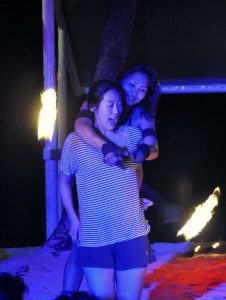
female dancers. It turns out they’re ladyboys, young transsexuals. I chatted to one, Maria, the attractive, curvy brunette in her mid-twenties who had just terrified the Japanese girl. Speaking in excellent English, (although with a noticeably husky voice,) she explained that several dance troupes like hers worked the bars along the beach, doing a forty-five minute show in each.
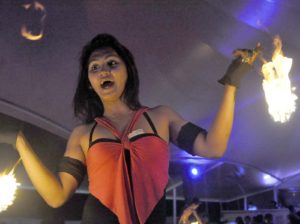
“There’s so much prejudice against us, even in a place like this, it’s hard to get regular jobs. But we dance for tips and make more than the bar staff.” She shrugs. “The tourists love it, so the owners are happy.” Sharing the take with the others in her troupe, Maria, a native of Boracay, makes £15 or more a night. That’s enough for her to rent a nice room and have a comfortable life. She slips my 300 pesos (£5) contribution into her dress top beside the neat fan of notes already there, and grins cheerfully before heading back to work.
Three cocktails each for myself and my companion, and a plate of sisig (spicy fried minced pork) to share, at Sand Bar, came to 900 pesos, or £15. Add in tips for the dancers and it was still a great evening’s entertainment for very little expense. While on this subject, by the way, tipping is not mandatory anywhere in the Philippines. Tip if you think the service was worth it, or when the recipient has no other means of payment, like the dancers.
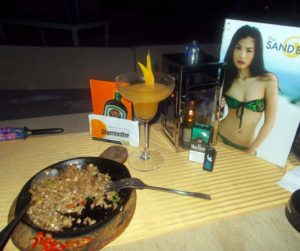
There’s music everywhere along the beach, with plenty of live bands both in the more conventional bars and set up under the palm trees. It’s all free, but once again, tips are appreciated. Filipinos are famously talented musicians, and apparently can turn their hands to any style. In just a few minutes’ walk, I heard reggae, rock, jazz, soul. (The one modern style I didn’t hear was country, for which I am extremely grateful.) Everywhere is the same: great music, nice atmosphere, and while it’s certainly busy, it’s not uncomfortably crowded. Most of the tourists, probably 75%, are Asians, either Filipinos on a short break or Chinese, Japanese or Koreans here for a longer stay; everyone is incredibly polite.
Commercialism is inevitable in a successful resort, and here it is definitely more noticeable than on other Philippine resort islands, like Palawan, but compared to Phuket or Pattaya in Thailand, or any southern European resort, it is relaxed, low-pressure and chilled. There’s plenty of opportunity to spend money, but I never felt I had to. Even the street-vendors were relaxed, which is unusual.
The Flip-Side
It’s not all up-side though. For families with younger children, there’s very little to do on Boracay. There are no lifeguards on the beach and dedicated child-friendly facilities are restricted to those you can find at the hotels. In any case, just getting there would be a harrowing journey for them. For older, less active people, there’s also little provision, other than the golf resort, and even getting about may pose problems, since the beach road is just sand.
A Fantastic Place for Couples
However, Boracay is great for anyone teenage and up who likes to mix beach life with active fun during the day and plenty of lively entertainment at night. It’s a fantastic place for couples, singles or families whose kids are a little older and can appreciate the adventure. Plus the beach itself is unquestionably one of the most beautiful in Asia, which means the world. It feels very safe and I saw no drunkenness or bad behaviour.
Given the quality of the natural attractions and the wide range of activities and excursions available, coupled with the vibrant night-life, and the good peso exchange rate, Boracay is not only a great destination but a relatively cheap one.
Typical Boracay Accommodation Prices:
Boracay is an established and popular resort, so prices are in general a little higher than other Philippines provincial destinations.
Budget hostel:
from £10/ per person per night. Very basic level of accommodation, shared dorm and bathroom. Suitable only for backpackers.
Midrange:
from £25/per room per night. Fan cooled double room with en-suite. Breakfast usually not included, wifi and other facilities may be available. These can be very nice but in hotter seasons may be uncomfortable.
From £35/night upwards, double room with en-suite, wifi, air-conditioned, usually with breakfast. Up to two children can often stay at no extra cost as long as they don’t use extra bedding, but a breakfast surcharge will be applied. There will usually be a swimming pool and restaurant.
Deluxe:
Up to £400 and more. The full range of facilities expected from top-quality international-standard luxury hotels is available.
Bear in mind that internet booking agencies mark up prices, so it may be worth contacting the hotel direct.
Money:
There are ATM cash dispensers in D’Mall, that will take either Visa or Mastercard. Using these is probably the most convenient way to get spending money. but be aware that they sometimes run out of cash!
However, remember that your bank may charge for ATM withdrawals, and so may the local bank. BDO and BPI do not take a commission, others do. Further, you’re limited in how much you can take per day, so you can’t just take out a lot in one go to save fees (which in itself is hardly secure.) It makes sense to actually pay for things with the card rather than to draw cash to use for shopping.
There is still a lot to be said for traveller’s cheques in the currency you will be using. Firstly, there is protection built in and they should be replaced quickly if stolen. As well as this, having a specific amount is a handy brake on the temptation to hit the ATM every time the funds go down, without realising how much you’re spending! If you use a good currency-exchange tracker like xe.com, then you can arrange to buy when the exchange rate is in your favour. One commission only is paid.
The alternative is to take cash either in your local currency and change in the Philippines, or in pesos bought at home. This will probably give you a small margin on the ATM exchange rate and as with traveller’s cheques, you can buy your pesos when the exchange rate gives you the best value. However, carrying large amounts of cash is never a good idea, and I suggest keeping it in the hotel safe.
Finally, there are still many places in the Philippines where you will not find an ATM, so having at least some funds in cash or traveller’s cheques, which are universally accepted, is a good idea.
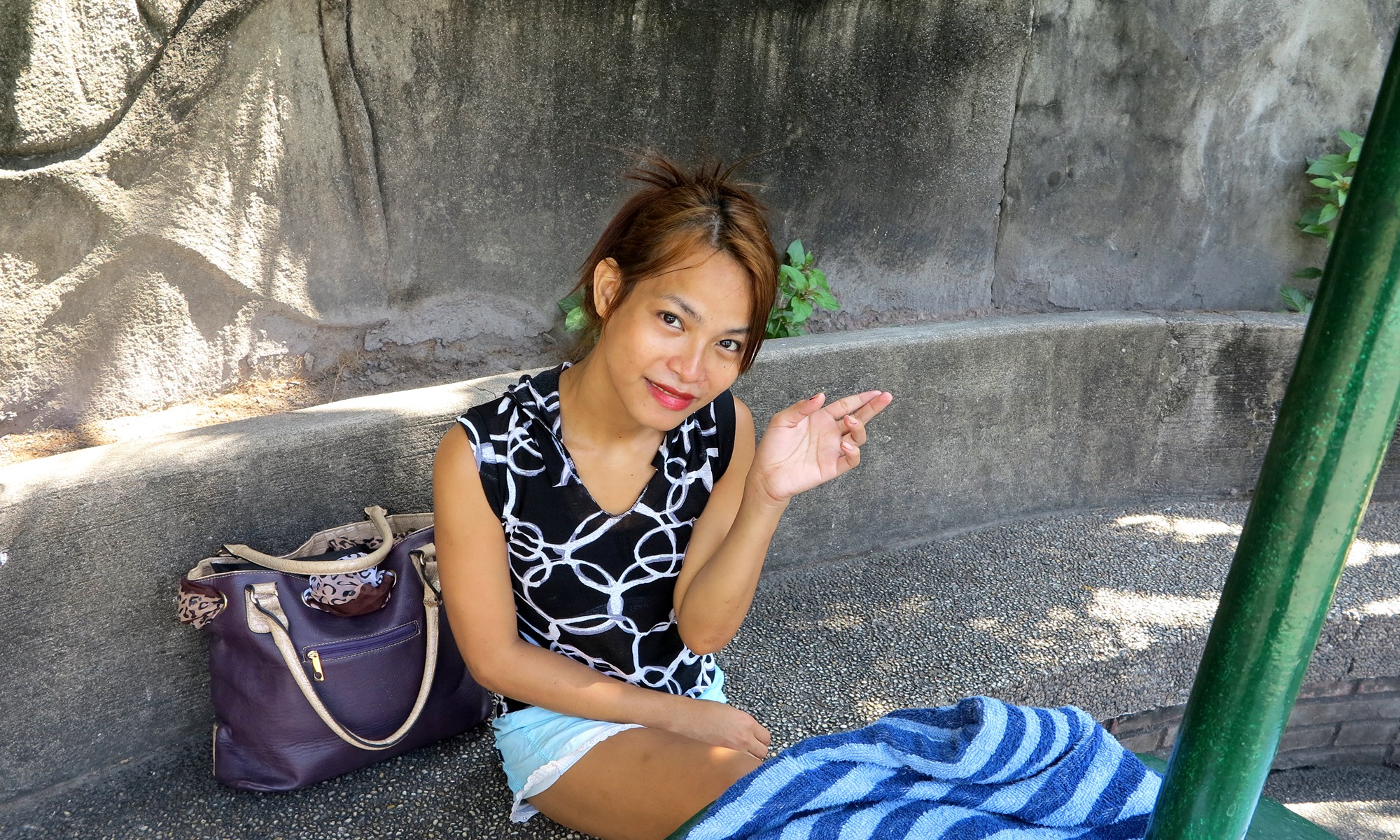

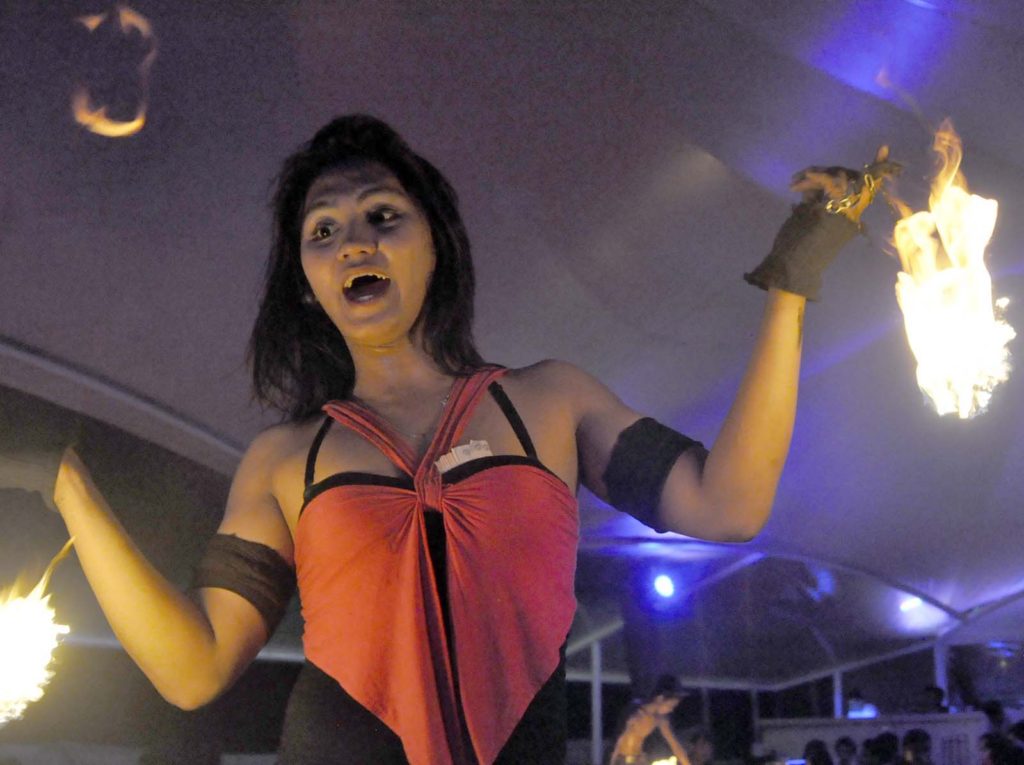


very nice beach paradise in the philippines…
one of the place i will never forget..unforgetable place with someone special in your life….
promice that going to come back there to enjoy more the beautiful beach and white sand there…
so guys what are you waiting for come and visit BORACAY in the philippines…
its really more fun in the philippines…
Wow thanks Crissy!